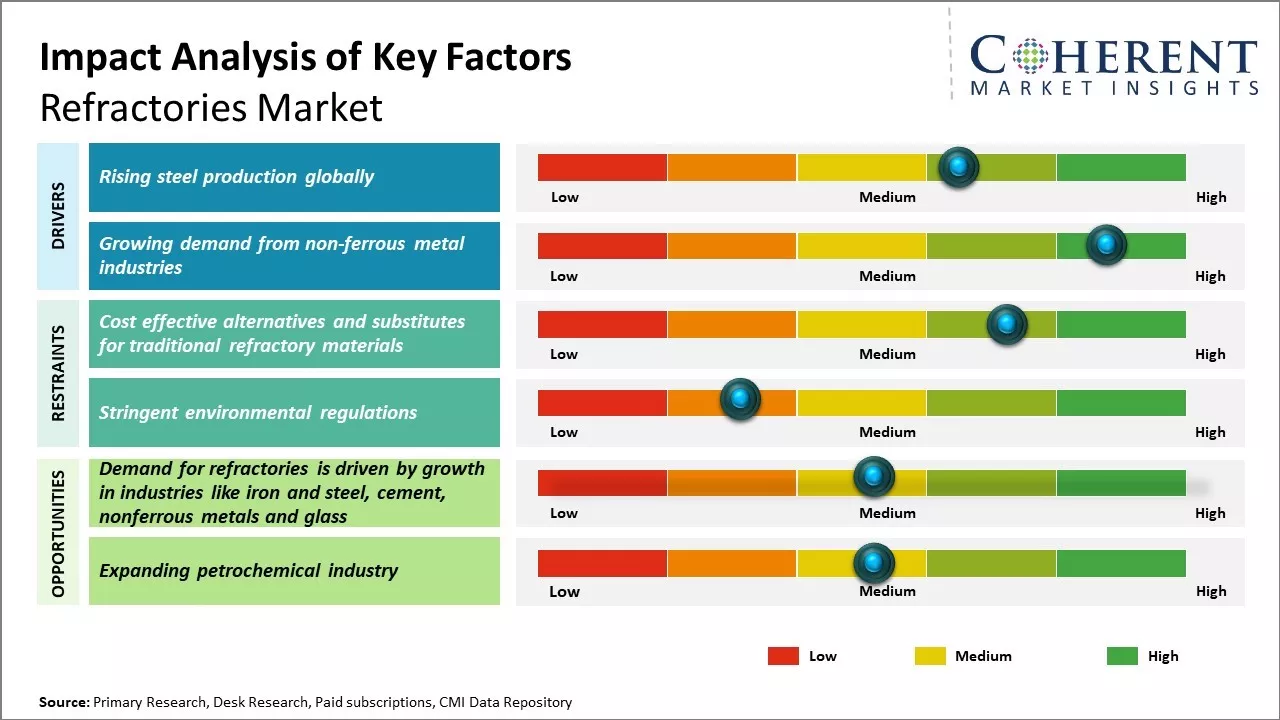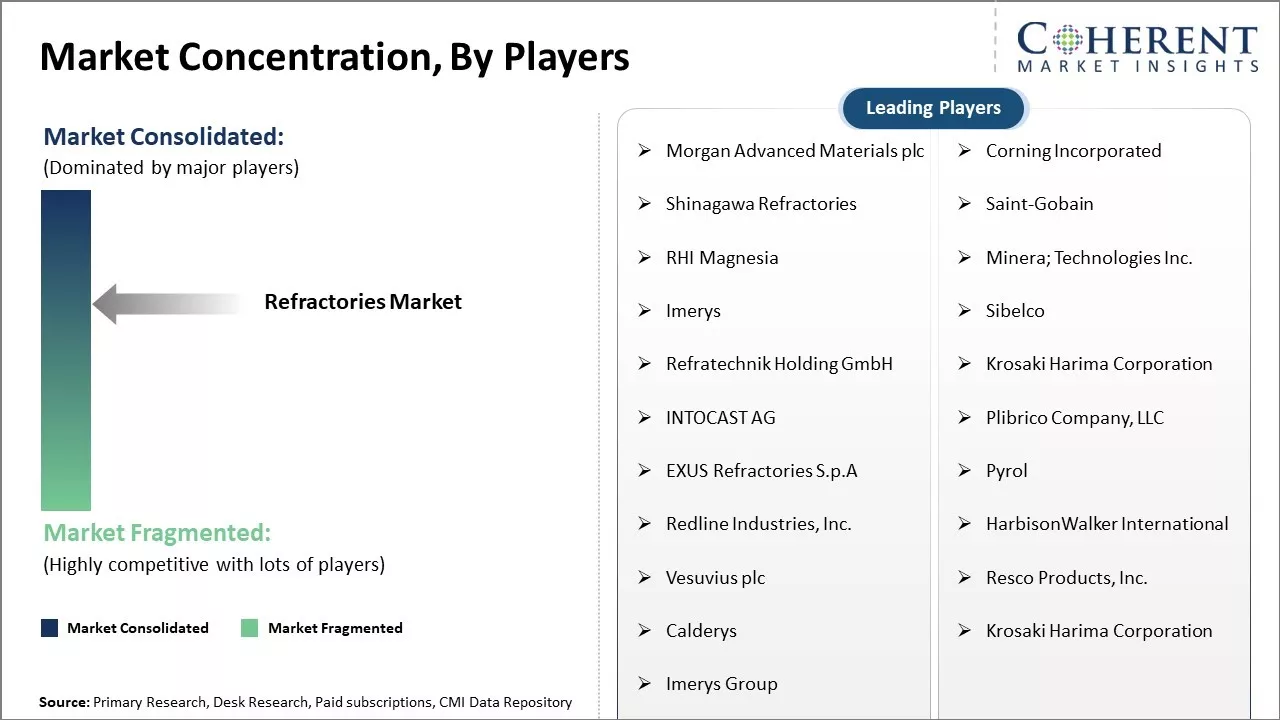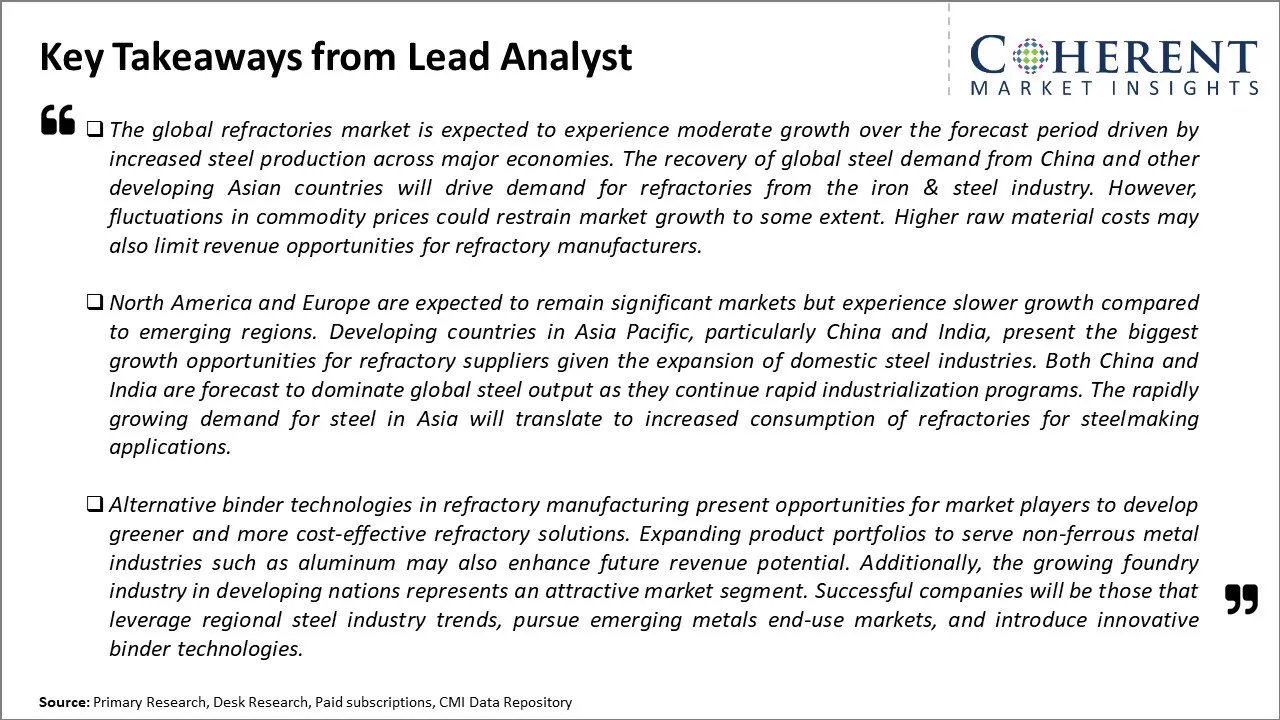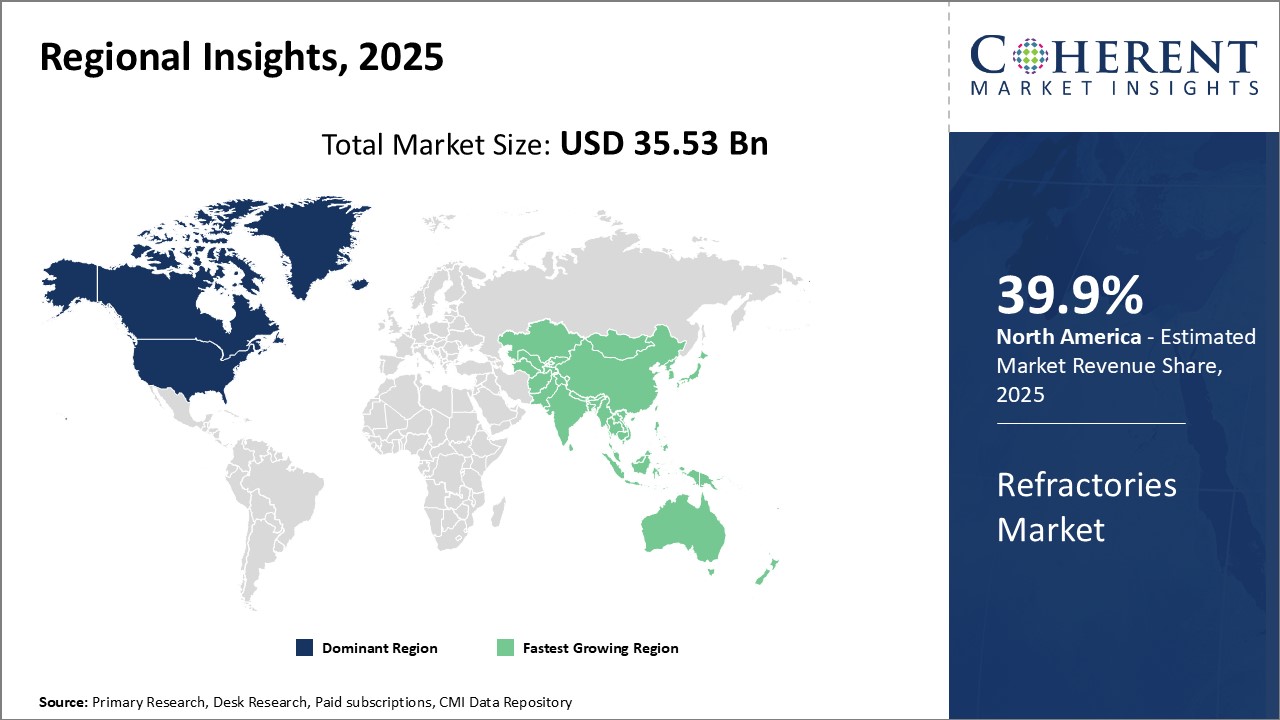The refractories market is estimated to be valued at US$ 35.53 Bn in 2025 and is expected to reach US$ 47.11 Bn by 2032, growing at a compound annual growth rate (CAGR) of 4.1% from 2025 to 2032.

Discover market dynamics shaping the industry: Request sample copy
Refractories are heat-resistant materials that are widely used in various industries such as iron and steel, cement, non-ferrous metals, glass, and others to line furnaces, reactors, and kilns. The market is expected to witness robust growth over the forecast period. This can be attributed to increasing steel production driven by infrastructure development projects across the globe. Additionally, rising energy demand along with expansion of the power and cement industries will also augment the adoption of refractories. However, volatility in raw material prices may hamper the revenue generation of refractories manufacturers to a certain extent.
Rising steel production globally
The refractories market is highly dependent on the production and consumption of steel worldwide. Steel is one of the most widely used engineered materials with applications across various end-use industries such as construction, automotive, machinery, etc. Refractory materials have widespread applications in steel production as linings for furnaces, reactors, and ladles used in steel making. They protect the steel making equipment from deterioration at high temperatures and absorption of impurities in molten steel.
Continued economic growth in developing countries is expected to fuel higher the demand for steel to support the growing infrastructure and construction sectors. Countries like China and India are anticipated to spearhead the global steel demand given their huge population and long term urbanization and industrialization goals. Both nations have outlined ambitious targets for infrastructure development which will directly translate to higher steel consumption. Additionally, other Asian countries and regions including Southeast Asia are witnessing a construction boom which bodes well for sustained steel demand.
In the western world as well, steady recovery in construction activity along with capacity additions in the automotive industry are positive indicators. The need for modernization and replacement of aging infrastructure in developed economies presents new avenues. Advanced economies are also focusing on renewable energy generation which utilizes steel. The overall momentum in steel consuming industries underscores robust demand outlook for refractories into the foreseeable future. Major steel makers have lined up large brownfield and greenfield expansion projects that require a steady refractory supply.

Get actionable strategies to beat competition: Request sample copy
Growing demand from non-ferrous metal industriesApart from steel, refractory materials are critical to several other high temperature metal manufacturing processes. Non-ferrous metals like aluminum, copper, zinc, nickel and titanium have wide end-use applications ranging from transportation, packaging to machinery. Their production typically involves complex metallurgical reactions at high temperatures well above 1,000 degrees Celsius. Under such harsh operating conditions, refractory linings are indispensable to shield the core processing equipment.
Aluminum production has been on an upward growth path supported by the exponential increase in its usage across different sectors over the last decade. Stringent environmental regulations are also inducing shift towards aluminum from other metals. On the other hand, consumption of copper continues to be driven by electrical industry, construction, and consumer electronics.

To learn more about this report, Request sample copy
Market Challenges: Cost effective alternatives and substitutes for traditional refractory materialsCustomers are increasingly seeking more cost effective alternatives and substitutes for traditional refractory materials. Stringent environment regulations around the world are hampering growth. High raw material costs, energy costs and costs of production also add pressures. Refractory material requirements are demanding as they must withstand high temperatures and harsh chemical environments. This necessitates ongoing R&D investments to develop innovative products. Additionally, consolidation has reduced the number of vendors, concentrating economic power within the industry.
Market Opportunities: Demand for refractories is driven by growth in industries like iron and steel, cement, non-ferrous metals, and glass
Demand for refractories is driven by growth in industries like iron and steel, cement, non-ferrous metals, and glass. Emerging economies are industrializing rapidly and investing in infrastructure, boosting refractory needs. Technological upgrades at client sites also promote refractory replacement. New performance-enhancing materials that strengthen equipment and lower costs could gain increased adoption

Discover high revenue pocket segments and roadmap to it: Request sample copy
Insights By, Form- Bricks & Shaped Leads Due to Customization CapabilitiesIn terms of form, bricks & shaped is expected to contribute 64.2% of the market share in 2025 due to its customized production capabilities. Bricks & shaped refractories are manufactured as per client requirements in various shapes and sizes which allows for precise fitting inside furnaces and kilns. Their modular production also facilitates easy replacement of worn out or damaged parts. This has increased their usage in areas that demand regular repairs and maintenance such as steel plants and petrochemical units. The ability of bricks & shaped refractories to withstand high corrosion and withstand thermal shock has boosted their popularity. Their resistance to slag penetration and ability to retain strength and density at elevated temperatures elevates their performance compared to other form factors. Additionally, custom designs catering to unique process parameters of different end-use industries have strengthened brand loyalty for major refractory brick producers.
Insights By, Product- Clay Dominates Due to Cost Effectiveness
In terms of product, clay is expected to hold 59.6% of the market share in 2025 due to its cost competitive nature. Clay refractories utilize locally available raw materials like kaolin and ball clay, thereby involving lower procurement costs compared to other refractory types. Their production also requires less energy and lower firing temperatures, reducing manufacturing expenses. Greater availability of kaolin reserves globally has ensured stable supply chains for clay refractories even during times of resource constraints. The cost benefits have increased their affordability, especially for smaller industries and developing regions. While non-clay types exhibit better corrosion resistance, clay remains the material of choice where budget is a critical factor for purchase decisions.
Insights By, Alkalinity- Basic Refractories Lead in the Steel Industry
In terms of alkalinity, basic is projected to contribute 69.9% of the market share in 2025 driven by rising steel production. Basic refractories containing magnesium oxide and calcium oxide work exceptionally well in the highly corrosive environment of steel melting shops and ladles. They protect the steel from re-absorption of oxygen and other gases due to their ability to form a protective slag layer. Their resistance to penetration and erosion by molten steel slag at 1,500°C or above has boosted replacements of acidic & neutral refractories in core steelmaking applications. Rapid infrastructure growth and rising vehicle manufacturing in Asian countries in particular has spurred huge demand from the ferrous alloy sector. The upsurge in crude steel output will continue driving higher consumption of basic refractories designed for slags in primary steelmaking.

Need a Different Region or Segment? Customize now
North America has remained the dominant region and is expected to hold 39.9% of the market share in 2025. The region is home to some of the largest steel producing nations like the U.S. and Canada. With an established steel industry infrastructure, North America enjoys considerable advantages when it comes to refractory materials demand and supply chain connectivity. Most of the big refractory manufacturers have their presence across major steel producing hubs, ensuring just-in-time delivery for steel plants. Additionally, the presence of superior railway and roadway networks facilitates efficient transport of heavy refractory bricks within the region.
Among other regions, Asia Pacific has emerged as the fastest growing market for refractories in recent years. This can be attributed to the rapidly expanding steel production capacities across developing nations like China and India. Being the current global leaders in crude steel output, these countries are investing heavily in setting up new steel mills and modernizing existing ones. This requires massive refractory materials to support the overhaul. Domestic manufacturers are struggling to fully meet this spiking demand, forcing countries to increasingly rely on imports. While import dependence remains relatively lower than other regions, it is steadily rising given the widening demand-supply gap.
This rising reliance on imports presents lucrative opportunities for overseas suppliers. Countries like Japan and South Korea have gained substantial hold in the Asia Pacific refractories trade, leveraging their technical expertise and quality consistency. Regional players are countering this by advancing their production technologies, diversifying their product portfolio, and achieving more economies of scale. They have also started exploring export potential to offset constraints in domestic capacities. This has made Asia Pacific a highly competitive refractories marketplace with continual technology and quality upgradation.
Refractories Market Report Coverage
| Report Coverage | Details | ||
|---|---|---|---|
| Base Year: | 2024 | Market Size in 2025: | USD 35.53 Bn |
| Historical Data for: | 2020 To 2024 | Forecast Period: | 2025 To 2032 |
| Forecast Period 2025 to 2032 CAGR: | 4.1% | 2032 Value Projection: | USD 47.11 Bn |
| Geographies covered: |
|
||
| Segments covered: |
|
||
| Companies covered: |
Morgan Advanced Materials plc, Corning Incorporated, Shinagawa Refractories, Saint-Gobain, RHI Magnesia, Minera; Technologies Inc., Imerys, Sibelco, Refratechnik Holding GmbH, Krosaki Harima Corporation, INTOCAST AG, Plibrico Company, LLC, EXUS Refractories S.p.A, Pyrol, Redline Industries, Inc., HarbisonWalker International, Vesuvius plc, Resco Products, Inc., Calderys, Krosaki Harima Corporation, and Imerys Group |
||
| Growth Drivers: |
|
||
| Restraints & Challenges: |
|
||
Uncover macros and micros vetted on 75+ parameters: Get instant access to report
*Definition: The refractories market includes products made from heat-resistant materials like ceramics, lime, high alumina, and dolomite. Refractory materials are used in high-temperature industrial processes like steelmaking, petrochemical manufacturing, cement production, and power generation. They are designed to retain their strength and resist thermal shock even when exposed to extreme heat. Common refractory products include shaped refractory bricks, monolithics, refractory mortars, and other specialized ceramic formulations used as linings or walls.
Share
Share
About Author
Ramprasad Bhute is a Senior Research Consultant with over 6 years of experience in market research and business consulting. He manages consulting and market research projects centered on go-to-market strategy, opportunity analysis, competitive landscape, and market size estimation and forecasting. He also advises clients on identifying and targeting absolute opportunities to penetrate untapped markets.
Missing comfort of reading report in your local language? Find your preferred language :
Transform your Strategy with Exclusive Trending Reports :
Frequently Asked Questions
Joining thousands of companies around the world committed to making the Excellent Business Solutions.
View All Our Clients
US Reciprocal Tax Impact Analysis On Refractories Market
Stay updated on tariff changes with expert insights and timely information